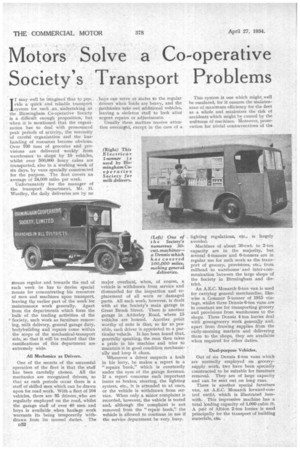Motors Solve a Co-operative Society's Transport Problems
Page 118

If you've noticed an error in this article please click here to report it so we can fix it.
IT may well be imagined that to pro-, vide a quick and reliable transport system for such an_ undertaking as the Birmingham Co-operative Society is a difficult enough proposition, but when it is mentioned that the organization has to deal with pronounced peak periods of activity, the necessity of careful organization and the husbanding of resources become obvious. Over 700 tons of groceries and provisions are delivered weekly from warehouses to shops by 10 vehicles, whilst over 500,000 fancy cakes are transported, also in a' working week of six days, by vans specially constructed for the purpose. The fleet covers an average of 24,000 miles per week.
Unfortunately for the manager of the transport department, Mr. H. Woolley, the daily deliveries are by no
means regular and towards the end of each week he has to devise special means for concentrating his resources of men and machines upon transport, leaving the earlier part of the week for maintenance work generally. Apart from the departments which form the bulk of the trading activities of the Society, such work as furniture removing, milk delivery, general garage duty, bodybuilding and repair's come within the scope of the mechanical-transport side, so that it will be realized that the ramifications of this department are extremely wide.
All Mechanics as Drivers.
One of the secrets of the successful operation of the fleet is that the staff has been carefully chosen. All the mechanics are recognized drivers, so that as rush periods occur there is a staff of skilled men which can be drawn upon for road work. With a fleet of 104 vehicles, there are 95 drivers .who are regularly employed on the road, whilst the garage staff of over 40 men and boys is available when haulage work warrants its being temporarily 'withdrawn from its normal duties. The
n52 boys can serve as mates to the regular drivers when loads are heavy, and the mechanics take out additional vehicles, leaving a skeleton staff to look after urgent repairs or adjustments.
Usually these matters receive attention overnight, except in the case of a
major overhaul, when, of course, a vehicle is withdrawn from service and dismantled for the inspection and replacement of all worn or damaged parts. All such work, however, is dealt with at the Society's main garage in Great Brook Street. There is another garage in Adderley Road, where 15 vehicles are housed. Another point worthy of note is that, so far as possible, each driver is appointed to a particular vehicle. It has been found that, generally speaking, the man then takes a pride in his machine and tries to maintain it in good condition mechanically and keep it clean.
Whenever a driver suspects a fault in his lorry, he makes a report in a "repairs 'book," which is constantly under the eyes of the garage foreman. If a report concerns such important items as brakes, steering, the lighting system, etc., it is attended to at once, or the vehicle is withdrawn from service. When only a minor complaint is recorded, however, the vehicle is tested and, although the complaint is not removed from the "repair book,!' the vehicle is allowed to continue in use if the service department be very busy. This system is one which might well be emulated, for it ensures the Maintenance of maximum efficiency for the fleet as a whole and minimizes the risk of accidents which might hr., caused by the unfitness of machines. Moreover, prosecution for trivial contraventions of the lighting regulations, etc., is largely avoided.
Machines of about 30-cwt. to 2-ton capacity are in the majority, but several 4-tonners and 6-tonners are in regular use for such work as the transport of grocery, provisions, etc:, from railhead to warehouse ' and inter-communication between the large shops of the Society in Birmingham and district.
An A.E.C. Monarch 6-ton van is used for carrying general merchandise, likewise a Commer 5-tonner of 1915 vintage, whilst three Dennis 6-ton vans are in constant use for transporting grocery and provisions from warehouses to the shops. Three Dennis 4-ton lorries deal with greengrocery work generally and, apart from drawing supplies from the early-morning markets and delivering them to the shops, they are available when required for other duties.
Dual-purpose Vehicles.




















































































































































































